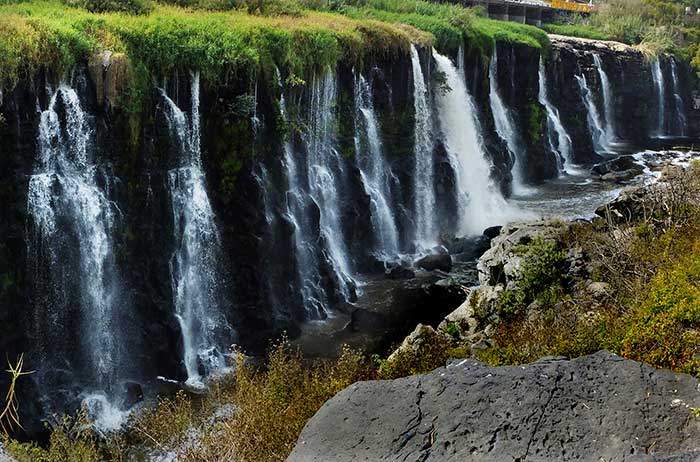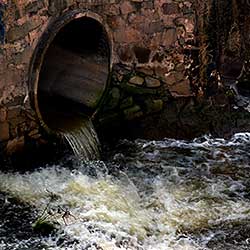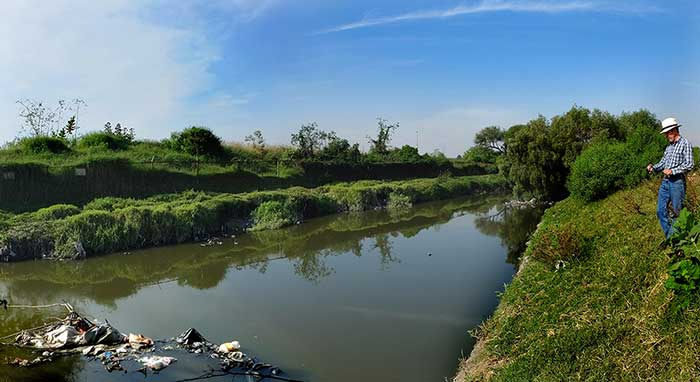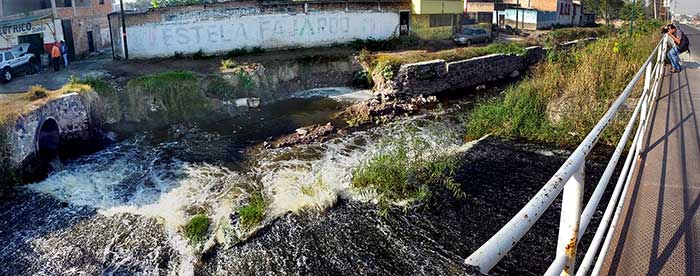|
By John Pint

El Salto de Juanacatlán: no more clouds of toxic foam
The 66 kilometer-long Río Ahogado is located southeast of Guadalajara,
Mexico's second-largest city, and feeds into the Río Santiago. For
years, that which it injected into the Santiago was a noxious mixture
of human waste, toxic chemicals and heavy metals. The one point where
the true nature of these aguas negras was made visible for all the
world to see was a wide waterfall called El Salto de Juanacatlán, where
the cascading water churned up billows of toxic foam said to be so
corrosive it could remove paint from cars. In 2008, Miguel Ángel López,
an eight-year-old boy fell into this disgusting soup and died not of
drowning but of swallowing some of the river water which, it was later
learned, contained 400 times more arsenic than the highest level
permitted.
This state of affairs was all the more notorious because long ago El
Salto had been considered one of the glories of Jalisco, “The Niagara
of Mexico” and, right up until the 1970s tourists came from far and
wide to stand in its spray and marvel at its beauty. Thirty years
later, they might have landed in the hospital if not in the morgue.
For years, I had wanted to see this toxic waterfall with my own eyes,
but I feared the results of just breathing the air in the neighborhood.
Then, only a month ago, I had a chat with a friend, biological
researcher José Luis Zavala.
“El Salto?” he said. “You can visit it anytime you want—it's all been
cleaned up.” I did a double-take and so did everyone else in the room.
“Yes,” he continued, “public outcry over the death of little Miguel
Ángel finally spurred officials to do something. They built a
300-million-peso treatment plant and the toxic foam has disappeared.”
“This I've got to see,” I said, coercing José Luis to act as a guide.
 A few days before Christmas, off we went to follow the course of the
Ahogado River to El Salto. Our first stop was at a point just next to
Guadalajara's Beltway, the Periférico and the Airport Road to Chapala.
At the corner of two streets quaintly named Biblia and Rosario we
pulled up next to what looked like a drainage ditch and stepped out of
the car to be hit by a stench that nearly gagged us. A young lady was
pushing a baby carriage across a bridge over this canal which was, in
fact the natural bed of the Ahogado River. Ahogado, perhaps
appropriately, means “drowned man.”
A few days before Christmas, off we went to follow the course of the
Ahogado River to El Salto. Our first stop was at a point just next to
Guadalajara's Beltway, the Periférico and the Airport Road to Chapala.
At the corner of two streets quaintly named Biblia and Rosario we
pulled up next to what looked like a drainage ditch and stepped out of
the car to be hit by a stench that nearly gagged us. A young lady was
pushing a baby carriage across a bridge over this canal which was, in
fact the natural bed of the Ahogado River. Ahogado, perhaps
appropriately, means “drowned man.”
“The raw sewage from all the houses around here flows directly into
this arroyo,” said José Luis, “and here is where the problem
begins.”
Our next stop along the course of this river of sewage was a spot only
100 meters north of Guadalajara International Airport. Did
you ever wonder why the airport of the City of Roses smells like basura (garbage)
and not at all like flowers? Well, the “river” flowing right next to it
is pure sewage with great gobs of garbage floating on its surface.
Amongst the plastic bags, worn-out tires and “icebergs” of Styrofoam,
we spotted the bloated corpse of a dead dog. To make matters worse, it
appears that airport waste water is flowing directly into this
pestilential stream, making it even worse. How sad that the first
impression visitors have of this city is the smell of garbage and
excrement! 
The Ahogado River, full of sewage and garbage, seen 100 meters from Guadalajara's Airport.
Just across the highway from the airport, the river flows right into a
grim-looking swamp called La Presa del Ahogado, which stinks to the
high heavens. Because it's officially a wetland, it's Federal property.
All around it are located factories: textile manufacturers, toolmakers,
etcetera. All of them seem to be spilling their residues into the
smelly bog.
“We are studying the
quality of the Ahogado by taking samples of the river sediment in
different areas and trying to raise earthworms in the dirt,” commented
Zavala. "Mud from some sites we sampled in this swamp must be
especially bad because all our worms died.”
This apparently toxic sewage now flows out of the wetland and at last
reaches the El Ahogado Treatment Plant which went into operation in
March of 2012. We weren't able to visit the plant due to the
bureaucracy which would be involved, but newspaper reports say the
plant now produces 1850 liters of clean water per second and eventually
will be able to handle 2250. At the plant's grand opening, José Luis
Luegue, director of Conagua, the National Water Commission, said,
referring to the boy who died of drinking the river water, that “we can
now say the Río Santiago is free of arsenic.”
The Ahogado waters flow into the Río Santiago. Less than ten kilometers
east of the treatment plant we were able to appreciate the results of
the cleanup. Here the Santiago is maybe 100 meters wide. Grass and
shade trees grace the river bank and I could detect no evil smell.
Coots were swimming in the river and we even found small fish in it!
The water looks crystal clear, but I definitely would not try to drink
it.
From the riverside we walked to the notorious El Salto Cascades,
thinking about the Youtube
video showing Greenpeace volunteers covered head to toe in
hazmat suits, bobbing on a raft barely visible beneath a meter of toxic
foam.
All gone now. The waterfall is actually quite pretty, though there
wasn't much flow because it was the dry season. As for the smell, it's
tolerable. If the treatment plant ever reaches Stage Two, the
Juanacatlán Falls might actually become “Mexico's Niagara” and the
tourist attraction it once was. I would definitely like to come back
and visit this place during the rainy season.
Downstream, of course, the pollution continues, but the Ahogado Plant
now gives Tapatios a glimmer of hope that the Santiago may someday
recover from what human beings have done to it.
If you, too, would like to see El Salto for yourself, it's easy to get
to get to, both from Guadalajara and the lakeside. Just follow the
directions below...but don't bother bringing a swim suit!
How to get there
Five kilometers south of the airport get on to the highway to El Salto
and head east. Drive 9.6 kilometers to the street appropriately called
“A Juanacatlán.” Turn right here. The road heads south and then curves
northeast. After 1.1 kilometers you come to Calle Constitución. Turn
right and cross the bridge over the waterfall. The very first street
after the bridge is called Calle Arenal. Turn left here and park. From
here it's just a 160-meter walk to the mirador for gazing at the
waterfall. You can also drive a short distance south on Calle Arenal
and park alongside the picturesque river bank. You'll find the driving
route from the Airport Road to the waterfall on Wikiloc.com under
“Salto Juanacatlan." 
Nature
photographer Jesús "Chuy" Moreno shoots the drain where sewage flows
out of Las Pintas Lake, on its way to the Santiago River.
|

